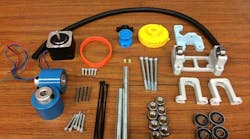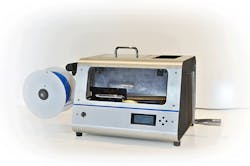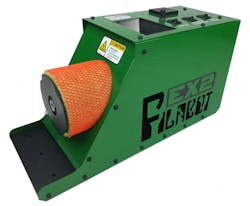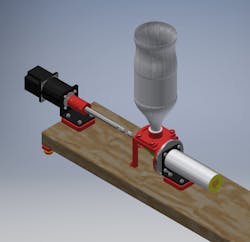It should be apparent to most people that while plastics are great to design with, they’re hard on the environment. While the U.S. has started recycling programs, the amount of plastic produced every year overshadows what gets recycled. In addition, energy is needed to collect and process materials, which can impede on overall benefit to recycling. Single-use plastics are particularly damaging. Resources and energy for a water bottle, party cup, etc. goes into the trash or back into the recycling stream, while only being used for a single drink. This has led to multiple researchers, engineers, and Makers to look for a better solution.
One of the problems with recycling is transportation—moving post-consumer polymers from consumer to recycling location and back to the processor. 3D printing has disrupted transportation. With its ability to decentralize manufacturing, parts can be emailed and printed on location.
However, the feedstock must be shipped. If you could find a decentralized feedstock or polymer, you could eliminate transportation. This brings things full circle: There is plastic waste almost everywhere, and a 3D printer that uses plastic to make practically anything. All that is missing is something to turn waste plastic into filament.
If you have a 3D printer, not only do you probably have failed prints and prints that are no longer needed, but there are probably some plastic bottles around you. Most plastic produced in the U.S. is Polyethylene Terephthalate (PET), also known as plastic #1. This material is easy to find, and can be used in some 3D printers.
ABS is one of the more popular filaments used in 3D printing, and its processing temperatures are similar to PET. There are more factors that will need to be considered when printing with the different materials. Depending on the grade of material, or the condition of the recycled polymer, the melt temperatures could vary along with their melt flow index.
Production of the ProtoCycler, which is capable of grinding and re-extruding plastics for 3D printing, began after a successful crowd-sourcing campaign.
Some companies, such as b-pet, are even producing recycled PET filament. However, other companies are taking it a step further. ProCycler and Filabot are making desktop solutions to grind and extrude your own polymer practically anywhere. Recently, researchers at Michigan Technological University in Houghton Mich., released all the open-source files online to build a machine that can recycle polymers and turn them into filament.
At Maker Faire 2015, Filabot displayed its offer multiple desktop solution, which allows users to extrude or pelletize recycled or new types of plastics.
The benefit of making your own is the ability to control and change more properties. The paper released from the university mentions that small extruders on the market, as well as the freely posted designs, suffer from one or more of the following deficiencies:
- Not open-source (thus, does not provide adequate control and customizable features needed for laboratory work
- Do not have adequate control (e.g., single-speed), which is needed for non-uniform feedstocks of waste plastic
- Are made from components that are not robust enough to handle contamination, as well as composite waste
- Demand machining experience and access to equipment often unavailable for DIY systems
- Have high costs
- Have slow extrusion rates
- Have limited temperature ranges, so cannot do some thermopolymers
- Do not have a reliable form of process observation (e.g., filament diameter monitoring)
With the focus on producing and recycling polymers for research or lab use, researchers explore the full potential of distributed recycling of post-consumer polymer waste. The university paper describes a research-grade recyclebot, which is a waste plastic extruder capable of making commercial quality 3D printing filament. The device design takes advantage of both the open-source hardware methodology and the paradigm developed by the open source self-replicating rapid prototyper (RepRap) 3D printer community. Specifically, this paper describes the design, fabrication, and operation of a RepRapable Recyclebot, which can provide the filament needed to largely replicate itself.
Results
The device costs less than $700 in materials and can be fabricated in about 24 hours. The Recyclebot produces 0.4 kg of filament per hour using 0.24 kWh of energy per kilogram produced with a diameter of ±4.6%. Thus, filament can be manufactured from commercial pellets for less than 22% of commercial filament costs. In addition, it can fabricate recycled waste plastic into filament for 2.5 cents/kg, which is around 1,000 times commercial filament costs. The system can fabricate filament from polymers with extrusion temperatures less than 250oC. These temperatures make the equipment capable of manufacturing custom filament over a wide range of thermopolymers and composites for material science studies of new materials, recyclability studies, and novel applications of fused filament-based 3D printing.
Size and Scale
To see the full Michigan Technological University paper, click here. To contact Joshua Pearce from the university’s Department of Material Science and Engineering, e-mail him at [email protected]. In 2015, worldwide plastic production was 322 million tons per year and is growing 3.86%/year. Both landfilling and incineration of plastic create well-established health and environmental issues. Rather than follow a linear model of materials use, a circular economy model can be used to provide sustainability by separating economic growth from resource consumption. Thus, recycling is now established in the circular economy as the optimum treatment of post-consumer plastics.
Unfortunately, there can be significant environmental impacts from the collection and transportation of relatively low-density waste plastics to collection centers and reclamation facilities for separation and reconstruction in traditional recycling. In addition, in developing regions (and even in some developed economies) the labor for this recycling is provided by waste pickers, who collect post-consumer plastic in landfills, among other places, far below poverty-level wages. To reduce the embodied energy of transportation needed for centralized recycling, while at the same time potentially improving the financial situation of waste pickers, a distributed recycling paradigm has been proposed.
Some of the parts for the recyclebot can be made on a 3D printer.
One method of distributed plastic recycling is to upcycle plastic waste into 3D printing filament with a recyclebot, which is an open-source waste plastic extruder. Previous research on the life cycle analysis (LCA) or the recyclebot process using post-consumer plastics instead of raw materials, showed a 90% decrease in the embodied energy of the filament from the mining, processing of natural resources, and synthesizing compared to traditional manufacturing.
In addition, the recyclebot provides the potential for consumers to recycle plastic in their own homes to save money by offsetting purchased filament. Recyclebots are also useful for laboratory and industry prototyping research, as failed prototypes are recycled into filament for future work. There have been many versions of recyclebot developed by both companies (e.g., Filastruder) as well as individuals (e.g., Lyman), including open-source versions from the Plastic Bank, Precious Plastic, and Perpetual Plastic. There are also several commercial versions of the recyclebot, including the Filastruder, Filafab, Noztek, Filabot, EWE, Extrusionbot, Filamaker (which also has a shredder), Strooder, and Felfil (OS), that can work with waste plastic.
Additionally, there are several examples of commercialized recycled filament (e.g., Filamentive, Fila-cycle, and Refil). However, most filament research, as well as production, is still accomplished with large-scale extruders inappropriate for distributed recycling. These systems range from $6,000 to tens of thousands of dollars for manufacturing-level extrusion lines that can produce a few kg/hr.




